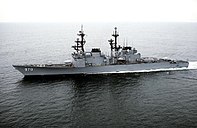1986 Black Sea incident
| Date | March 13, 1986 |
|---|---|
| Location | Black Sea |
| Coordinates | 44°13.5′N 34°09.3′E / 44.2250°N 34.1550°E |
| Type | Purposeful naval collision |
| Target | United States Navy vessels:
|
| Perpetrator | Soviet Navy vessels:
|
On March 13, 1986, the American cruiser USS Yorktown and the destroyer USS Caron tried to exercise the right of innocent passage under international law through Soviet territorial waters in the Black Sea near the southern Crimean Peninsula. They were confronted by Soviet frigate Ladny and border guard vessels Dozorny and Izmail.[1]
Yorktown and Caron stayed in Soviet territorial waters for roughly two hours.[1] The situation de-escalated when the U.S. ships left; diplomatic repercussions continued for several weeks.[2]
Background
"The Rules of Navigation and Sojourn of Foreign Warships in the Territorial Waters and Internal Waters and Ports of the USSR", enacted by the
At the time, the Soviet Union recognized the right of innocent passage for warships in its territorial waters solely in designated
Incident
On March 10, 1986, the
The Russian state-run
Aftermath
Soviet protest
The
U.S. stance
Replying to the Soviet
In the subsequent incident of 1988, the same USS Yorktown and USS Caron, while claiming innocent passage again in the Black Sea, were bumped by the Soviet vessels.[12]
See also
- 1988 Black Sea bumping incident
- 2003 Tuzla Island conflict
- 2018 Kerch Strait incident
- 2021 Black Sea incident
Notes
- ^ a b c d e Aceves, p. 249
- ISBN 978-9004174795.
- ^ a b c Aceves, p. 248
- ^ Aceves, p. 245
- ^ Kraska & Pedrozo 2013, pp. 255–256
- ^ Kraska & Pedrozo 2013, p. 256
- ^ William J. Aceves. "Diplomacy at Sea: U.S. Freedom of Navigation Operations in the Black Sea". International Law Studies. 68.
- ^ a b c d e f W.E. Butler (April 1987). "The Black Sea Affair" (PDF). American Journal of International Law. Retrieved September 7, 2017.
- ^ "25 лет ПСКР "Дозорный"" (in Russian). Pogranichnik.ru. Retrieved January 27, 2016.
- ^ Izvestiya(in Russian). Retrieved September 7, 2014.
- ^ ISBN 978-9004217737.
- Philadelphia Media Network. Retrieved September 6, 2014.
References
- Aceves, William J. "Diplomacy at Sea: U.S. Freedom of Navigation Operations in the Black Sea". International Law Studies. 68.
- Kraska, James; Pedrozo, Raul (2013). International Maritime Security Law. Martinus Nijhoff Publishers. ISBN 978-9004233577.




